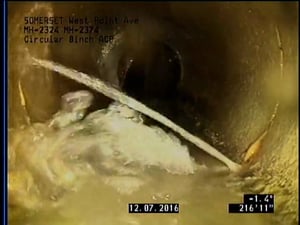 Inflow and infiltration (I&) is a risk in any waste system. Yet in regions with older infrastructure, groundwater and stormwater that enter a sewer system can account for as much as 50% of flow. The cost of this disruption should not be underestimated; in 2014 the EPA reported that wastewater collection and treatment expenses ranged from $2 to $5 per thousand gallons, and that number has only increased since. An annual I&I volume of 150 million gallons would cost between $300,000 and $750,000 per year to transport and treat. Given that even small amounts translate into substantial costs, where should you draw the line on I&I? How much is too much?
Inflow and infiltration (I&) is a risk in any waste system. Yet in regions with older infrastructure, groundwater and stormwater that enter a sewer system can account for as much as 50% of flow. The cost of this disruption should not be underestimated; in 2014 the EPA reported that wastewater collection and treatment expenses ranged from $2 to $5 per thousand gallons, and that number has only increased since. An annual I&I volume of 150 million gallons would cost between $300,000 and $750,000 per year to transport and treat. Given that even small amounts translate into substantial costs, where should you draw the line on I&I? How much is too much?
Excessive Infiltration
The answer isn’t straightforward. Infiltration occurs when groundwater enters the sanitary sewer system through damaged or decayed pipes and access points. The EPA’s Project Certification Standards defines infiltration as excessive if the average dry weather flow (DWF) is more than 120 gallons per capita per day (gpcd). This quantity includes domestic wastewater flow, infiltration and nominal industrial and commercial flows.
While this metric provides a good rule of thumb, it has also been criticized for its simplicity. It fails to incorporate factors like the intensity of precipitation events and varying groundwater levels. Instead, many states use alternate or additional measures to establish reasonable rates of infiltration. Some prefer a criterion of gallons per day per inch of diameter per mile of pipe (gpd/idm). Per alternate EPA methods, “Metcalf & Eddy’s text ‘Wastewater Engineering: Collection and Pumping of Wastewater’, suggests that infiltration rates for whole collection systems (including service connections) that are lower than 1500 gpd/idm are not usually excessive.” The Massachusetts Department of Environmental Protection addresses the issue more broadly: Its definition of excessive infiltration includes any infiltration sources “which can cost-effectively be removed from the sewer system, based on a comparison of the cost of removal to the cost of transporting and treating the flows.”
Addressing Inflow
Likewise, excessive inflow–stormwater that enters the sewer system through rain leaders, basement sump pumps or foundation drains illegally connected to the sewer–has been measured according to a variety of standards. Inflow is stormwater that enters the sewer system through rain leaders, basement sump pumps or foundation drains illegally connected to the sewer. The EPA’s benchmark is 275 gallons per capita per day, a number established based on the average wet weather flow in more than 45 different sewer systems. Yet it also takes into consideration the feasibility and cost-effectiveness of eliminating sources of inflow. Regardless of the numbers, if a plant experiences hydraulic overflows during storm events, the inflow is excessive. As with infiltration, Massachusetts’s definition of excessive inflow revolves in part around the financial impact of the situation and includes “all public and private inflow sources, unless existing conditions render such removal technically infeasible or cost-prohibitive.” Essentially, all inflow is excessive, unless it’s too pricey to remove it.
Taking the Next Steps
Your region may rely on entirely different standards, so staying up to date on the most recent regulations is the only way to avoid fines or government interventions. Even if tests reveal that you fall within the legally “non-excessive” range, however, smart municipalities are always on the lookout for sources of I&I and ways to reduce it. Today, more advanced and effective solutions for both spot repair and end-to-end repair are available on the market. And better inspection tools and equipment now enable you to catch problems more efficiently. Envirosight’s white paper, Combating Inflow & Infiltration From the Inside Out, provides advice and recommendations for identifying and eliminating excessive I&I in your system:
Check out our comprehensive research page on diagnosing, measuring and solving inflow and infiltration.

